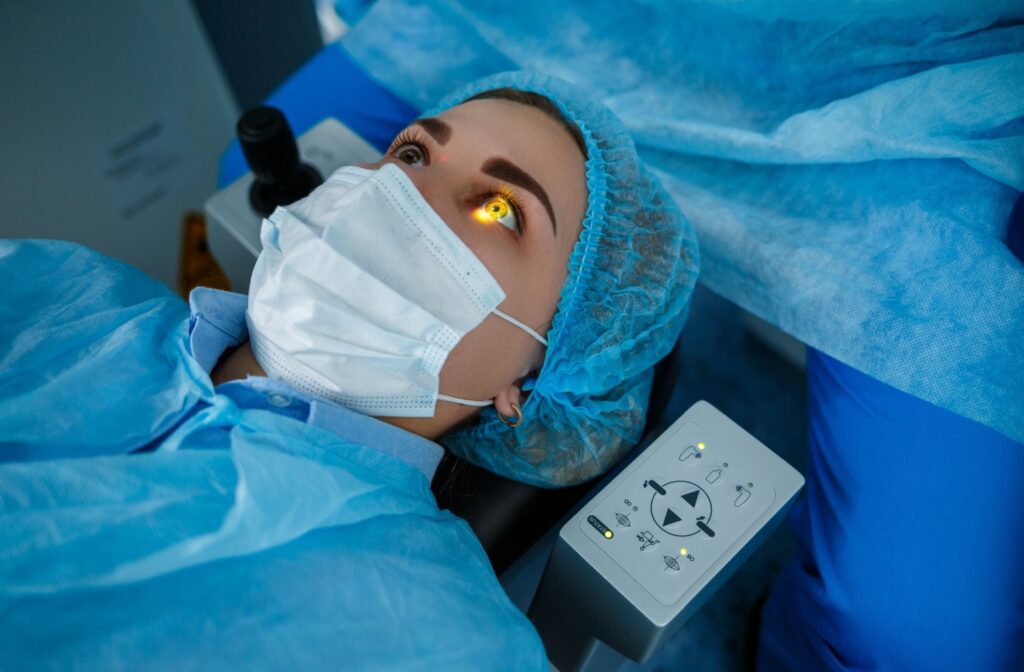Laser eye surgery, particularly LASIK (Laser-Assisted in Situ Keratomileusis), is a life-changing procedure for many. If you wear glasses or contact lenses, the promise of waking up with improved vision may seem like a dream come true.
The road to the operating room might seem lengthy. Not only do we have to evaluate your eyes to establish your candidacy, but the ophthalmology clinic will also need to perform a few tests of its own. Inside the exam room, however, the surgery itself is quick, taking about 30 minutes altogether.
From the moment you take a seat in our exam chair, our team is here to support and guide you on your LASIK surgery journey.
A Closer Look at LASIK Surgery
Laser eye surgery, or refractive surgery, includes procedures like LASIK or PRK (Photorefractive Keratectomy) that correct refractive errors such as astigmatism, myopia, and hyperopia. These conditions occur because of changes to the eye’s physical shape, which these surgeries aim to improve.
LASIK is the most popular type of laser eye surgery, known for its precision and minimal recovery time. LASIK involves reshaping your cornea so that your eye focuses light directly onto your retina, producing clearer vision.
The Timeline for LASIK Eye Surgery
On the day of your surgery, the actual procedure is generally quick, taking about 10 minutes per eye.
That said, “laser eye surgery” doesn’t just refer to time spent under the laser. The overall experience—including preparation, pre-surgical consultations, the actual procedure itself, and recovery—all matter.
Here’s a closer look at how it all unfolds:
Pre-Surgical Consultation (30 minutes to 1 hour)
LASIK surgery might be popular, but it’s still a medical procedure that requires your healthcare team to do their diligence.
The process isn’t as simple as walking into your nearest clinic and then getting under the laser. LASIK requires a thorough evaluation to verify whether you’re a candidate for surgery or whether another procedure, like PRK, is better suited to your situation.
Here’s what you can expect during this consultation:
- Review your medical history and current health.
- Measure your corneal thickness to ensure suitability for surgery.
- Conduct tests to map your eye’s unique shape and prescription.
While you can also visit your optometrist for an initial consultation, your eye surgeon will likely conduct an exam of their own. They are, after all, the ones performing your surgery!

Day of the Surgery (Procedure Time: 15 to 30 minutes)
As far as surgeries go, LASIK is pretty simple. It’s an outpatient procedure, which means you’re free to go home (with a driver) once your eye surgeon clears you to leave. This happens shortly after surgery.
About 10 to 15 minutes before the procedure, your surgeon will:
- Apply numbing drops to your eyes so that they feel comfortable and relaxed. This is like an anesthetic for your eye; you might feel mild pressure during the surgery, but no pain.
- Hold your eyelids open with tiny speculums, so that you don’t blink during surgery. Don’t panic about accidentally moving your eyes; it happens. Modern lasers are designed to track eye movements, so they adjust automatically if you move.
- Align you under the laser system while they briefly explain the surgical process.
Once you’re under the actual laser, the procedure takes about 10 minutes per eye. Here’s what happens:
- A small corneal flap is created and lifted back.
- The laser reshapes your cornea to correct your vision.
- The flap is repositioned to complete the surgery.
Once this process is complete, you’ll rest for a bit until you’re cleared to go home.
Post-Surgery Recovery (Initial Hours to a Few Days)
Recovery begins immediately after the procedure. While the exact timeline varies, you can expect:
- First 24 Hours: Your vision might be hazy at first, but many patients notice significant improvements within hours. It’s normal to experience mild itching or sensitivity, but avoid rubbing your eyes.
- Follow-Up Appointment: Your doctor will likely schedule a checkup the day after surgery to monitor your healing.
- 1 Week: Most people can return to normal activities like driving, working, and exercising.
- 3-6 Months: For some, it can take a few months for their vision to become stable.
LASIK boasts a quick recovery time. Most people are back to their routines after just 2-3 days.
That said, it’s always better to take it slow, as your eyes are particularly delicate during the first few days. If you’re unsure about your healing time or if something feels off, visit your eye doctor immediately.
What Makes Laser Eye Surgery Worthwhile?
Though the total time commitment for laser eye surgery—including recovery—is minimal, its benefits are long-lasting:
- Convenience: Vision improvement can feel freeing. Even if you still need corrective lenses after your surgery, better vision might be worth the investment.
- Cost-Efficiency: Though the upfront cost may seem steep, it can save you money on glasses and contact lenses over time, especially if you need specialty lenses for higher prescriptions.
- Confidence Boost: Enjoy activities like swimming, running, or simply wearing sunglasses without the hassle.
LASIK offers an improvement, not a permanent solution. Your eyes are dynamic, changing as you grow older and with your lifestyle, which LASIK cannot prevent. Many people still develop age-related vision changes, like presbyopia, but this is natural, and isn’t caused by LASIK.
If you’re interested in LASIK surgery, here’s another way to look at it: Is 10 minutes per eye worth years of better vision? For some people, the answer is an outstanding “yes”.
The Road to Better Vision Starts Here
LASIK eye surgery is an exciting experience that many of our patients look forward to. And, we’re just as excited to be a part of this journey.
An initial consultation with our Total Vision La Mesa team can help you get started. Together, we’ll evaluate the health of your eye, corneal thickness, and vision to determine if LASIK is right for you.
Take control of your vision today. Book your consultation and see the world like never before.



